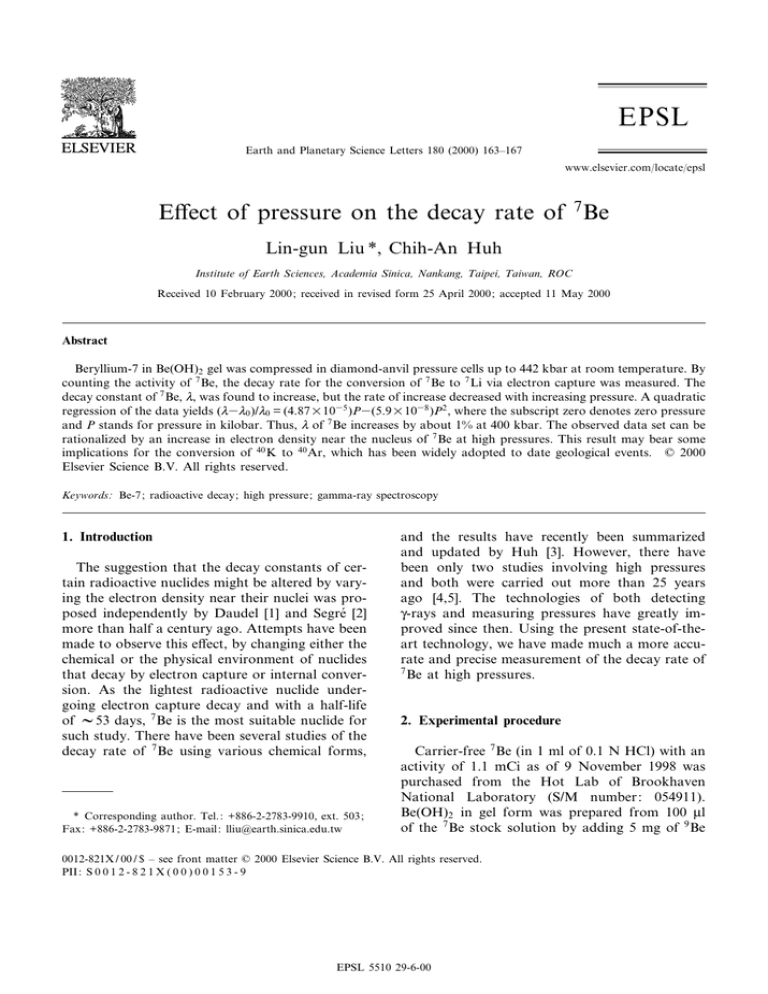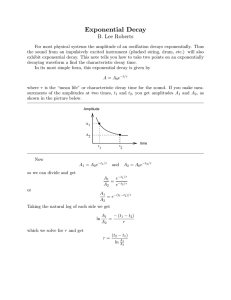
Earth and Planetary Science Letters 180 (2000) 163^167
www.elsevier.com/locate/epsl
E¡ect of pressure on the decay rate of 7Be
Lin-gun Liu *, Chih-An Huh
Institute of Earth Sciences, Academia Sinica, Nankang, Taipei, Taiwan, ROC
Received 10 February 2000; received in revised form 25 April 2000; accepted 11 May 2000
Abstract
Beryllium-7 in Be(OH)2 gel was compressed in diamond-anvil pressure cells up to 442 kbar at room temperature. By
counting the activity of 7 Be, the decay rate for the conversion of 7 Be to 7 Li via electron capture was measured. The
decay constant of 7 Be, V, was found to increase, but the rate of increase decreased with increasing pressure. A quadratic
regression of the data yields (V3V0 )/V0 = (4.87U1035 )P3(5.9U1038 )P2 , where the subscript zero denotes zero pressure
and P stands for pressure in kilobar. Thus, V of 7 Be increases by about 1% at 400 kbar. The observed data set can be
rationalized by an increase in electron density near the nucleus of 7 Be at high pressures. This result may bear some
implications for the conversion of 40 K to 40 Ar, which has been widely adopted to date geological events. ß 2000
Elsevier Science B.V. All rights reserved.
Keywords: Be-7; radioactive decay; high pressure; gamma-ray spectroscopy
1. Introduction
The suggestion that the decay constants of certain radioactive nuclides might be altered by varying the electron density near their nuclei was proposed independently by Daudel [1] and Segrë [2]
more than half a century ago. Attempts have been
made to observe this e¡ect, by changing either the
chemical or the physical environment of nuclides
that decay by electron capture or internal conversion. As the lightest radioactive nuclide undergoing electron capture decay and with a half-life
of V53 days, 7 Be is the most suitable nuclide for
such study. There have been several studies of the
decay rate of 7 Be using various chemical forms,
* Corresponding author. Tel.: +886-2-2783-9910, ext. 503;
Fax: +886-2-2783-9871; E-mail: lliu@earth.sinica.edu.tw
and the results have recently been summarized
and updated by Huh [3]. However, there have
been only two studies involving high pressures
and both were carried out more than 25 years
ago [4,5]. The technologies of both detecting
Q-rays and measuring pressures have greatly improved since then. Using the present state-of-theart technology, we have made much a more accurate and precise measurement of the decay rate of
7
Be at high pressures.
2. Experimental procedure
Carrier-free 7 Be (in 1 ml of 0.1 N HCl) with an
activity of 1.1 mCi as of 9 November 1998 was
purchased from the Hot Lab of Brookhaven
National Laboratory (S/M number : 054911).
Be(OH)2 in gel form was prepared from 100 Wl
of the 7 Be stock solution by adding 5 mg of 9 Be
0012-821X / 00 / $ ^ see front matter ß 2000 Elsevier Science B.V. All rights reserved.
PII: S 0 0 1 2 - 8 2 1 X ( 0 0 ) 0 0 1 5 3 - 9
EPSL 5510 29-6-00
164
L.-g. Liu, C.-A. Huh / Earth and Planetary Science Letters 180 (2000) 163^167
(initially dissolved in 1 ml of 1 N HCl) as the 7 Be
carrier followed by NH4 OH to form Be(OH)2
precipitate. After centrifugation to separate the
precipitate from the solution, the supernatant
water was removed. About one half of the precipitate was used for this study. Aliquots of the sample were loaded into four di¡erent types of diamond-anvil pressure cells (A, B, C and D in Table
1), each covering a certain range of pressures. A
hardened stainless steel gasket with a hole about
100^150 Wm in diameter and 60^80 Wm in depth
was sandwiched between the two diamond anvils
in each cell. Fine powders of ruby were then
placed inside the hole, and extreme care was taken
to load the sample inside the hole to ensure that
none of the sample was left outside the pressure
chamber. No pressure-transmitting medium other
than Be(OH)2 gel itself was used, and the whole
assembly was sealed by driving the diamond anvils together. Two of the samples recovered after
the high-pressure experiment (A and B) were later
examined by X-ray di¡raction and Raman spectroscopy. These samples appeared to be amorphous. An in situ Raman study of a newly prepared Be(OH)2 gel at 250 kbar showed that the
spectrum of the sample at high pressure was similar to that of the starting material, implying that
the sample remained amorphous at high pressure.
The latter phenomenon is in line with the pressure-induced amorphization of silicates [6] and
oxides [7] generally observed at room temperature.
Pressures were measured using the ruby-£uorescence technique. The hydrostaticity of the sample
at P 9 130 kbar, as estimated from the shape of
£uorescence bands of ruby, is close to that when a
water pressure medium is used, and it is judged to
be acceptable in the range 130^450 kbar. Based
on 10^25 measurements evenly distributed in the
pressure chamber of each sample, the experimental uncertainty in pressure varies from þ 1.5 kbar
around 30 kbar to þ 14 kbar around 440 kbar
(Table 1).
In order to accommodate the geometry and
weight of the di¡erent pressure cells, a special
stage was built to hold the pressure cells a few
millimeters above the HPGe Q-ray detector
(EGpG ORTEC GEM-150230), which was interfaced with a digital Q-ray spectrometer (EGpG
ORTEC DSPec1). The detector o¡ers a counting
e¤ciency of 150% (relative to 3U3 NaI) and a
resolution of 1.23 keV (FWHM) for the 7 Be photon peak centered at 477.56 keV. The counting
system provides extended live-time correction according to the Gedcke^Hale method [8] and automatically sets a threshold to reject pile-up of
pulse pairs at 0.5 Ws resolution. The outline and
orientation of each pressure cell were clearly
marked on the stage so that the position, geometry and sample-to-detector distance remained constant from run to run for each pressure cell. The
sample-to-detector distance ranged from V5 to
V15 mm above the center of the detector for
di¡erent pressure cells.
Table 1
Variation of the decay constant (V) of 7 Be in Be(OH)2 gel with pressure
Type of
pressure cell
Pressure
(kbar)
a
None
A
A
B
B
C
D
D
C
a
1 atm
28.2 þ 1.5
46.8 þ 4.7
92.3 þ 5.7
131.5 þ 10.7
145.3 þ 6.4
233.5 þ 6.1
311.3 þ 9.5
441.7 þ 13.8
Number of
pressure
measurements
Period of
counting
V
T1=2
(days)
(day31 )
(days)
^
10
10
15
9
25
15
14
18
110
72
77
78
72
91
53
55
87
0.0129769 þ 0.0000007
0.0129934 þ 0.0000023
0.0130048 þ 0.0000046
0.0130287 þ 0.0000040
0.0130461 þ 0.0000036
0.0130512 þ 0.0000010
0.0130848 þ 0.0000046
0.0131000 þ 0.0000047
0.0131068 þ 0.0000053
53.414 þ 0.003
53.346 þ 0.009
53.299 þ 0.019
53.202 þ 0.016
53.131 þ 0.015
53.110 þ 0.004
52.973 þ 0.019
52.912 þ 0.019
52.884 þ 0.022
By mounting and covering a 7 Be^Be(OH)2 source on a glass slide.
EPSL 5510 29-6-00
V3V0 /V0
0
0.00127 þ 0.00018
0.00215 þ 0.00036
0.00399 þ 0.00031
0.00533 þ 0.00028
0.00572 þ 0.00010
0.00832 þ 0.00036
0.00949 þ 0.00037
0.01001 þ 0.00041
L.-g. Liu, C.-A. Huh / Earth and Planetary Science Letters 180 (2000) 163^167
Activities of 7 Be in the sample at various pressures were assayed on a daily basis for one to two
half-lives of 7 Be (see Table 1). To compensate for
the decrease of count rate with time and maintain
compatible counting statistics between runs, the
counting time increased from V20 min at the
beginning to 3^4 h near the end of the experiment. The accumulated counts from 7 Be decay
for each run were generally in the order of 106 ^
107 , resulting in typical counting errors of
V0.03^0.1% ( þ 1c) for the data points. The starting sample at ambient conditions was also
counted in a well-type HPGe detector (EGpG
ORTEC GWL-100230) [3]. The decay rate of
7
Be in uncompressed sample obtained from these
two di¡erent detectors is identical (0.0129769
þ 0.0000007 vs. 0.0129765 þ 0.0000014 day31 ),
lending unequivocal support to the accuracy and
precision of our experiment. The stability of the
counting system was ensured by weekly calibration of the detector using a uraninite standard
solution. Throughout the course of this experiment there were no signs of any changes in energy, resolution and e¤ciency. The electronic
stability of the counting system was also monitored in some runs using the much longer-lived
152
Eu which was placed just outside the pressure
chamber as a real-time calibration standard.
165
Fig. 1. Exponential decay of 7 Be in Be(OH)2 gel at 46.8 þ
4.7 kbar. The horizontal line (At /A0 = 1) is decay-corrected
and normalized activity of 152 Eu which was placed outside
the pressure chamber of the diamond-anvil cell as a real-time
calibration standard. Error bars for the At /A0 values are actually much less than the size of the data points.
given. The uncertainty of the fractional increase in
our measurement is denoted by the vertical error
bars, which are sometimes smaller than the symbol size, and that of pressure is denoted by the
horizontal error bars. It should be noted that the
single datum point of Gogarty et al. [4] was calculated from a least-squares ¢t of 20 measurements near 100 kbar using 7 BeCO3 WBe(OH)2 as
the starting sample, and the three data points of
Hensley et al. [5] were obtained using BeO. There-
3. Results and discussion
A typical exponential decrease of 7 Be activity at
high pressure (At ), together with that of 152 Eu,
with time is shown in Fig. 1. To simplify the
plot, At is normalized against A0 (7 Be activity at
t = 0). Weighted least-squares ¢tting of the data
sets results in the decay constant V and the associated uncertainty ( þ 1c). As mentioned earlier,
uncertainties of our data points are 6 0.1%
( þ 1c) based on counting statistics. With 54^138
data points on the decay curve, the resulting uncertainty for V is 6 0.04% ( þ 1c). The experimental conditions and results are summarized in Table 1. The fractional increase in the decay
constant of 7 Be in Be(OH)2 gel as a function of
pressure obtained in the present study is shown in
Fig. 2, in which the data of earlier studies are also
Fig. 2. Fractional increase of the decay constant of 7 Be in
Be(OH)2 gel as a function of pressure. The line through our
data is the quadratic regression (see text). The data of Gogarty et al. [4] and those of Hensley et al. [5] are also shown
for comparison. According to Huh [3], there is a small, but
real, di¡erence in the decay constant of 7 Be in di¡erent
chemical forms. The present data were normalized using
V0 = 0.0129769 þ 0.0000007 day31 for Be(OH)2 gel. It is assumed that the data of Hensley et al. [5] were normalized using V0 for BeO.
EPSL 5510 29-6-00
166
L.-g. Liu, C.-A. Huh / Earth and Planetary Science Letters 180 (2000) 163^167
fore, the e¡ect of chemical forms on V should be
considered while comparing the data sets [3], as
discussed below.
In the present study, not only were more measurements made, but the pressure spanned was
more than 1.5 times that covered in the previous
studies and much more accurate measurements of
both decay constant and pressure were obtained.
Fig. 2 shows that the initial fractional increase in
the decay constant of 7 Be observed in the present
study is about twice that reported earlier. However, in contrast to the linear behavior reported
by Hensley et al. [5], the rate of increase was
observed to decrease with increasing pressure in
the present study. A quadratic regression of the
data yields (V3V0 )/V0 = (4.87U1035 )P3(5.9U
1038 )P2 with the regression coe¤cient R2 =
0.999, where the subscript zero denotes zero pressure and P stands for pressure in kilobar. Thus, V
of 7 Be increases by about 1% at 400 kbar.
The increase in decay constant in 7 Be at high
pressures can be rationalized in terms of an increase in electron density near the nucleus at
high pressures as predicted more than half a century ago. A rough calculation between the observed data and the compressional behavior of
BeO at high pressures was carried out by Hensley
et al. [5], though more rigorous theoretical calculations using more realistic models remain to be
made. The di¡erent results between the present
study and that of Hensley et al. may be interpreted as follows. If the electron density is inversely proportional to the volume, the lower
rate of increase in the decay constant of 7 Be observed by Hensley et al. [5] may be due to the
smaller compressibility of BeO, relative to
Be(OH)2 gel, at high pressure. Consequently, the
observed di¡erence in the results between Hensley
et al. [5] and this study is not unexpected.
The linear behavior of the data of Hensley et al.
[5] may be explained by the smaller range of pressures spanned in their experiment. Alternatively,
considering the uncertainties in measuring both
the decay constant and pressure in the experiment
of Hensley et al. [5], their data could also be ¢tted
with a quadratic regression. It is well known that
compressibility of solids decreases with increasing
pressure. The decrease in the rate of increase of
the decay constant of 7 Be at higher pressures observed in the present study is most likely a manifestation of the decrease in compressibility of
Be(OH)2 gel at higher pressures.
The conversion of 40 K to 40 Ar by electron capture has been widely adopted to date geological
events (e.g., [9^11]). If the e¡ect of pressure on the
decay rate of 7 Be observed in the present study
also occurs in 40 K, and K-containing minerals
were subjected to high pressures during their geological history, the ages of these materials determined by the conventional dating method might
be overestimated. However, since V of 7 Be increases by about 1% at 400 kbar, it would be
expected that a similar e¡ect on larger nuclides
such as 40 K would be smaller. We would like to
note here that, following our experiment on 7 Be,
another experiment was performed on 83 Rb, a
much bigger nuclide undergoing electron-capture
decay. For a nuclide of this size, no measurable
changes were observed up to 420 kbar at room
temperature.
Acknowledgements
We are indebted to C.-C. Lin for measuring
pressures and to J. Shen for acquiring the 7 Be
source, and the Institute of Atomic and Molecular
Sciences in our organization for constructing the
supporting stage used in the experiment. We also
bene¢ted greatly from the comments of both
W.A. Bassett and T. Dunai.[RV]
References
[1] R. Daudel, Alteration of radioactive periods of the elements with the aid of chemical methods, Rev. Sci. 85
(1947) 162.
[2] E. Segrë, Possibility of altering the decay rate of a radioactive substance, Phys. Rev. 71 (1947) 274^275.
[3] C.-A. Huh, Dependence of the decay constant of 7 Be on
chemical forms, Earth Planet. Sci. Lett. 171 (1999) 325^
328.
[4] W.B. Gogarty, S.S. Kistler, E.B. Christiansen, O¤ce of
Naval Research Technical Report 7, Washington, DC,
1963.
[5] W.K. Hensley, W.A. Bassett, J.R. Huizenga, Pressure de-
EPSL 5510 29-6-00
L.-g. Liu, C.-A. Huh / Earth and Planetary Science Letters 180 (2000) 163^167
pendence of the radioactive decay constant of Beryllium7, Science 181 (1973) 1164^1165.
[6] Q. Williams, E. Knittle, R. Reichlin, S. Martin, R. Jeanloz, Structural and electronic properties of FeSiO-fayalite
at ultrahigh pressures: amorphization and gap closure,
J. Geophys. Res. 95 (1990) 21549^21563.
[7] P. Richet, P. Gillet, Pressure-induced amorphization of
minerals: a review, Eur. J. Mineral. 9 (1997) 907^933.
[8] R. Jenkins, R.W. Gould, D. Gedcke, Quantitative X-ray
167
Spectrometry, Marcel Dekker, New York, 1981, pp. 266^
267.
[9] G. Faure, Principles of Isotope Geology, John Wiley and
Son, New York, 1986.
[10] R. Brown, Isotopes in the Earth Sciences, Elsevier, London, 1988.
[11] M.A. Geyh, H. Schleicher, Absolute Age Determination,
Springer-Verlag, Berlin, 1990.
EPSL 5510 29-6-00








